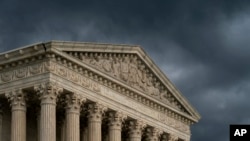The Supreme Court wrestled Tuesday with how much power the president should have to fire the head of an independent agency, a question important to future presidents of both parties.
The high court heard arguments in a case involving the Consumer Financial Protection Bureau, the agency Congress created in response to the 2008 financial crisis.
The agency was the brainchild of Massachusetts Senator Elizabeth Warren, a 2020 Democratic presidential candidate, and arguments took place as voters in 14 states were deciding whom they want to nominate to take on President Donald Trump in the next presidential election.
At the Supreme Court, Trump's administration argued that the president should be able to fire the CFPB's head for any reason. It was unclear from arguments how the court might rule, but the case seemed to divide the court's liberal and conservative members, with Chief Justice John Roberts' vote key to the outcome.
Justice Brett Kavanaugh, Trump's most recent appointee to the court, suggested existing restrictions on the president's ability to fire the head of the CFPB were "troubling" because they meant that a new president could be saddled with a CFPB director appointed in the previous administration.
"The next president in 2021 or 2025, or whenever, will have to deal with a CFPB director appointed by the prior president potentially for his or her whole term without being able ... to do anything about that difference in policy," Kavanaugh said.
'Modest' restrictions
But Justice Ruth Bader Ginsburg seemed willing to let the restrictions stand, describing them as "modest."
"It stops the president from at whim removing someone, replacing someone with someone who is loyal to the president rather than to the consumers that the bureau is set up to serve," she said.
Under the Dodd-Frank Act that created the CFPB, its director is appointed by the president and confirmed by the Senate to a five-year term. The president can remove a director only for "inefficiency, neglect of duty or malfeasance in office."
It was unclear from arguments whether the justices might let the restriction stand but interpret it in a way that gives the president broad power to remove the director; strip the restriction from the law; or resolve the case another way.
Defenders of the law's removal provision say it insulates the agency's head from presidential pressure. But detractors say the restriction is unconstitutional and improperly limits the power of the president.
The impact of the justices' decision in the case could go beyond the CFPB because the heads of other so-called independent agencies have a similar restriction on being fired. Those agencies include the Federal Reserve, Federal Deposit Insurance Corp., Federal Trade Commission, Federal Communications Commission and Securities and Exchange Commission. Unlike the CFPB, however, those agencies are headed by multimember boards.
How case originated
The case was brought to the court by the Orange County, California-based consumer law firm Seila Law. As part of an investigation, the CFPB demanded information and documents from the firm, which is run by a solo practitioner. Seila Law responded by challenging the CFPB's structure.
Two lower courts ruled against the law firm, upholding the restrictions on president's power to remove the CFPB's director. The fact that the dispute in front of the justices wasn't the result of the president trying to fire the CFPB's director weighed on at least one justice.
"Shouldn't we do what we've done for over 200 years of this country and wait until there's an actual dispute between the president and a director that he or she ... wants to fire?" Justice Sonia Sotomayor asked.





